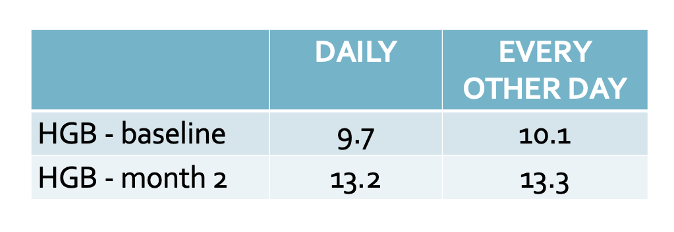Every Other Day Iron Dosing: A New Study
Every Other Day Dosing with Iron Sulphate Just as Effective as Daily Dosing in Premenopausal Women
Iron deficiency is the most common cause of anemia in the world. In 2019, the WHO estimated the global prevalence of anemia to be 29.6% in non-pregnant women. Iron deficiency anemia is thought to account for about 50% of all cases of anemia in women. Many of the current guidelines recommend that patients with iron deficiency anemia use iron supplements daily in attempt to bring the ferritin and hemoglobin levels back up to a normal range.
One of the issues with daily iron absorption are the side effects. Some patients have constipation and some have other GI upset issues like diarrhea. Some have nausea, dyspepsia, metallic taste in the mouth, epigastric discomfort which may reduce compliance to the treatment and longterm efficacy.
Furthermore, daily iron use may stimulate increased production of the protein hepcidin which may act to block further absorption. Some authors have been interested in studying whether daily iron use may actually be less effective than use every other day because of the fact that hepcidin gets stimulated to such a great extent in those that use daily.
To really understand this issue better, it’s helpful for us to first review a really important landmark study from 2017 as well as some additional study. Then we’ll come back to a new by Kaynar et al after that.
Stoffel NU et al. 2017
The Stoffel study showed us that taking iron every other day is probably just as effective (and perhaps more effective) as taking it daily. In the study, women were randomly assigned to two groups. One group was given 60 mg iron (as ferrous sulphate) in the morning on consecutive days for 14 days, and the other group was given the same doses on alternate days for twice as long - 28 days. 40 women were enrolled in the study. 21 women received daily iron and 19 received iron every other day. At the end of treatment (14 days for the consecutive-day group and 28 days for the alternate-day group), cumulative total iron absorption was 131 mg in the daily group compared to 175 mg in the every other day group. Serum hepcidin levels were greater in the consecutive-day group than the alternate-day group (p=0·0031).
Mehta S et al. 2020
In 2020 Mehta et al compared daily vs every other day iron supplementation in 40 patients (20 in each group. The authors showed that alternate day single tablet dosing schedule of oral iron therapy (60mg of elemental iron, ferrous sulfate) was more effective and better tolerated compared to daily supplementation in IDA. The authors showed that hepcidin levels increased more in the group using daily iron.
Kaynar et al. 2022
A new study set out to compare the effectiveness of daily vs every other day oral iron replacement therapy in women of reproductive age (18-50) with iron-deficiency anemia.
The authors included premenopausal female patients aged between 18 and 50 years with iron-deficiency anemia (hemoglobin<12 g/dl, ferritin<30 mcg/l, and/or transferrin saturation<15%).
Forty patients were given oral iron therapy at a daily dose of 160 mg (iron sulfate). Forty-three patients were given iron treatment at a dose of 160 mg (iron sulfate) every other day. After 2 months of oral iron therapy, there was a significant improvement in hemoglobin, mean corpuscular volume, serum iron, total iron binding capacity, and transferrin saturation in both groups. Overall, there were no differences between the groups suggesting that they both appear to be similarly effective. Hepcidin levels did not differ in a statistically significant way between the groups although levels did, of course, increase with iron therapy.
Conclusion
The conclusion of this study was that daily iron use and every other day iron use are probably similarly effective in health premenopausal women with iron deficiency anemia. It may be possible to improve patient compliance with the treatment can be increased by offering treatment every other day instead of daily.
REFERENCE
Kaynar et al. Comparison of daily oral iron replacement therapy with every other day treatment in female reproductive age patients with iron-deficiency anemia. Ann Hematol. 2022 Apr 23.
Stoffel NU et al. Iron absorption from oral iron supplements given on consecutive versus alternate days and as single morning doses versus twice-daily split dosing in iron-depleted women: two open-label, randomised controlled trials. Lancet Haematol. 2017 Nov;4(11):e524-e533.
World Health Organization (2021) Anaemia in women and children: WHO global anaemia estimates, 2021st edn. World Health Organization, Geneva 3. Cook JD (2005)
Mehta S et al. A Prospective, Randomized, Interventional Study of Oral Iron Supplementation Comparing Daily Dose with Alternate Day Regimen Using Hepcidin as a Biomarker in Iron Deficiency Anemia.J Assoc Physicians India. 2020 May;68(5):39-41.
This article was written by Dr. Jeff Donovan, a Canadian and US board certified dermatologist specializing exclusively in hair loss.


